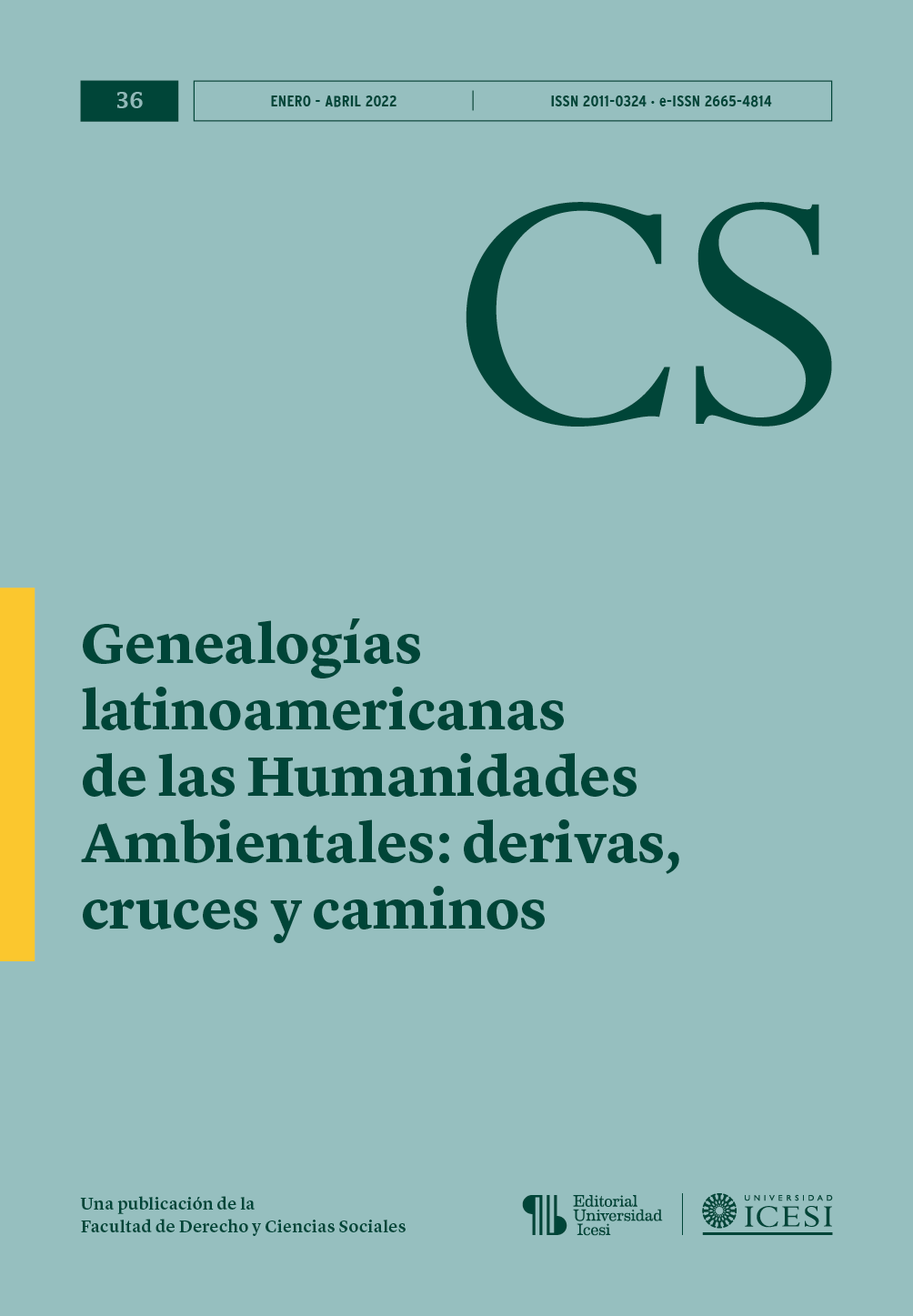Ecopolitical Mapping: A Multispecies Research Methodology for Environmental Communication
DOI:
https://doi.org/10.18046/recs.i36.5275Keywords:
Creative Methodologies, Collective Mapping, Environmental Communication, Multispecies Research, Cohabitation, CoexistenceAbstract
Ecopolitical Mapping is a methodology which seeks to map encounters of love and disaster between humans and their more-than-human surroundings. This methodology, first coined by an transdisciplinary group of artists and researchers in South Chile, unfolds through collective mapping sessions using an ecopolitical approach to trace the power relationships between different species-beings. In this research document, we unpack our engagements with this methodology in three different scales and territories: the Biobío Watershed (Chile), Berlin City (Germany) and Europe (Continent). Each case presented a strong environmental communication component, which ended up with the translation of the stories of the encounters into illustrated maps. The methodological approach proposed here is intimate, political and situated. The map evolves from a supposed politically neutral artifact into a tool for environmental education, communication, and activism. We offer the notionand approach, hoping that this methodology can be practiced and refined by other humans, allies of the tentacle kinship.
Downloads
References
Abram, David (1996). The Spell of the Sensuous. New York: Vintage Books.
Anderson, David George (2000). Identity and Ecolog y in Arctic Siberia: The Number One Reindeer Brigade. Oxford: Oxford University Press.
Bennett, Nathan J.; Roth, Robin; Klain, Sarah C.; Chan, Kai; Christie, Patrick; Clark, Douglas A....; Wyborn, Carina (2017). Conservation social science: Understanding and integrating human dimensions to improve conservation. Biological Conservation, 205, 93-108.
Bullard, Robert D. (2011). Sacrifice Zones: The Front Lines of Toxic Chemical Exposure in the United States by Steve Lerner. Environmental Health Perspectives,119(6), A266.
Casti, Emanuela (2014). A reflexive cartography and environmental conservation: a model of participatory zoning. Global Bioethics, 25(2), 125-135.
De Young, Raymond (2000). Expanding and evaluating motives for environmentally responsible behaviour. Journal of Social Issues, 56(3), 509-526.
Gibson, Katherine; Bird Rose, Deborah; Fincher, Ruth (2015). Manifesto for Living in the Anthropocene. Santa Barbara: Punctum Books.
Gillespie, Katie; Narayanan, Yamini (2020). Radical Intimacies: A Multispecies Politics of Care and Kinship. Retrieved from https://networks.h-net.org/node/73374/announcements/6578999/cfp-edited-volume-radical-intimacies-multispecies-politics-care
Haraway, Donna (2016). Staying with the trouble: Making kin in the Chthulucene. Durham: Duke University Press.
Hedesan, Jo; Tendler, Joseph (2017). An Analysis of Thomas Kuhn’s The Structure of Scientific Revolutions. London: Macat Library.
Hulme, Mike (2009). Why we disagree about climate change: Understanding controversy, inaction and opportunity. Cambridge: Cambridge University Press.
Huntington, Henry P. (1998). Observations on the Utility of the Semi-directive Interview for Documenting Traditional Ecological Knowledge. Arctic, 51(3), 237-242.
Kirksey, S. Eben; Helmreich, Stefan (2016). The Emergence of Multispecies Ethnography. Cultural anthropology, 25(4), 545-576.
Krueger, Tobias; Maynard, Carly; Carr, Gemma; Bruns, Antje; Mueller, Eva Nora; Lane, Stuart (2016). A transdisciplinary account of water research. Wiley Interdisciplinary Reviews: Water, 3(3), 369–389.
Latour, Bruno (2018). Down to earth: politics in the new climatic regime. Cambridge: Polity Press.
Linder, Rhema (2016). Analyzing Creative Processes: Qualitative Methods Meets Visual Analytics. Unpublished.
Maron, Martine; Simmonds, Jeremy S.; Watson, James EM (2018). Bold nature retention targets are essential for the global environment agenda. Nature Ecolog y & Evolution, 2(8), 1194-1195.
Moore, Jason W. (2015). Capitalism in the Web of Life: Ecolog y and the Accumulation of Capital.London: Verso Books.
Nygren, Anja; Rikoon, Sandy (2008). Political Ecology Revisited: Integration of Politics and Ecology Does Matter. Society & Natural Resources, 21(9), 767-782.
Okaka, Wilson (2016). Developing Effective Science Communication for Ecological Crisis, Climate Change, and Eco-Justice Issues in Africa. Conference: International Conference on Sustainable Alternatives to Ecological Justice for Poverty Reduction in Africa.
Pievani, Telmo (2014). The sixth mass extinction: Anthropocene and the human impact on biodiversity. Rendiconti Lincei, 25(1), 85-93.
Pohl, Christian (2011). What is progress in transdisciplinary research? Futures, 43(6), 618–626.
Risler, Julia; Ares, Pablo (2016). Manual of Collective Mapping. Buenos Aires: Argentina.
Robbins, Paul (2011). Political Ecology: A Critical Introduction. Malden: John Wiley & Sons.
Safiullin, Marat Rashitovich; Ermolaeva, Polina Olegovna; Yermolaev, Oleg Petrovich; Selivanov, Renat Nailevich (2015). Current Perspectives on Social Mapping of Urban Territories. Asian Social Science, 11(6), 207-213.
Schwarze, Steve (2007). Environmental Communication as a Discipline of Crisis. Environmental Communication, 1(1), 87-98.
Sharman, Martin; Mlambo, Musa C. (2012). Wicked: The problem of biodiversity loss. GAIA-Ecological Perspectives for Science and Society, 21(4), 274–277.
Stengers, Isabelle (2018). Another Science is Possible: A Manifesto for Slow Science. London: Polity Press.
Sterback, Elise (2014). Creative Ecology: A New Model For Resilience in Creative Communities. Wellington: Creative Coalition Auckland.
Tsing, Anna (2015). The mushroom at the end of the world: On the possibility of life in capitalist ruins. Princeton: Princeton University Press.
van Dooren, Thom; Kirksey, Eben; Münster, Ursula (2016). Multispecies Studies: Cultivating Arts of Attentiveness. Environmental Humanities, 8(1),1-23.
Wildnisstadt Berlin (2021). What if Berlin was a National Park City? Retrieved from: https://storymaps.arcgis.com/stories/d76ff4efd7f14c728f0307a0677d52f8
WWF (2018). Living Planet Report - 2018: Aiming Higher. Grooten, M. and Almond, R.E.A.(Eds). Gland, SwitzerlandL WWF
Published
Issue
Section
License
Copyright (c) 2022 Jens Benöhr

This work is licensed under a Creative Commons Attribution-NonCommercial 4.0 International License.
© Reserved Copyright
Material in this publication may be reproduced without authorization, provided the title, author and institutional source is acknowledged.
The content published in Revista CS is distributed under the Creative Commons BY-NC 4.0 Attribution/Recognition-NonCommercial 4.0 International license.
You are free to:
Share — copy and redistribute the material in any medium or format.
Adapt — remix, transform, and build upon the material.
Under the following terms:
Attribution — You must give appropriate credit , provide a link to the license, and indicate if changes were made . You may do so in any reasonable manner, but not in any way that suggests the licensor endorses you or your use.
NonCommercial — You may not use the material for commercial purposes.












